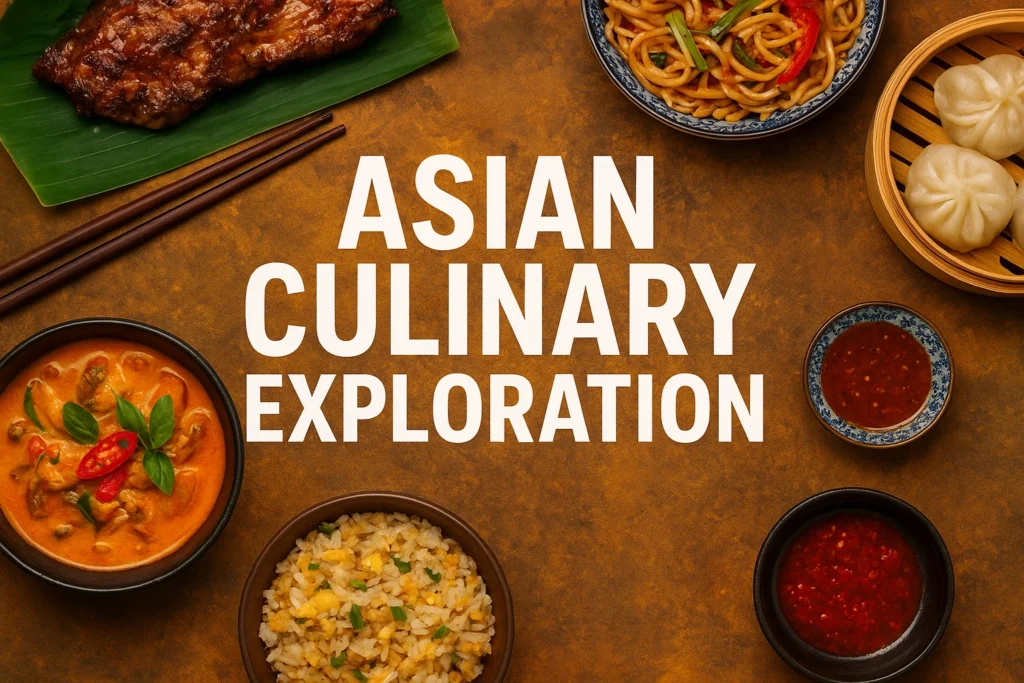The crackle of a wok. The sharp scent of ginger and chili. Steam fogging up the windows while someone hums by the stove. That’s Asian Culinary Exploration more than cooking, more than eating. It’s memory, history, and art mixed in one big bowl.
Walk through the streets of Bangkok, you smell smoke and lemongrass. Step into a small Tokyo kitchen, someone’s slicing fish like poetry. Food here isn’t just food. It’s pride, it’s ritual, it’s home.
The Cultural Essence Behind Asian Culinary Exploration
Food as Identity in Asian Culture
Asia lives through food. Festivals, prayers, family gatherings — all begin and end with a meal. A bowl of rice in Japan says balance. A thali in India says love.
Chef Masaharu Morimoto once said,
“Cooking is a philosophy; it’s not a recipe.”
That fits perfectly. Because recipes in Asia aren’t followed; they’re felt. Each handful of spice, a story.
No one cooks just to eat. They cook to remember.
Geography and Climate Shape the Plate
Asia’s map is flavor itself. The monsoon rains of India birthed rich curries. The sea around Japan taught restraint. High mountains in Nepal made warm stews a comfort.
| Region | Staple Ingredients | Cooking Technique | Example Dish |
| East Asia | Rice, soy, seaweed | Steaming, stir-fry | Ramen, Sushi |
| South Asia | Lentils, ghee, spices | Slow cooking | Biryani, Dal |
| Southeast Asia | Coconut, chili, herbs | Grilling, fermenting | Satay, Tom Yum |
This diversity defines Asian Culinary Exploration. Geography didn’t just shape the land. It shaped the tongue.
The Pillars of Asian Flavors
Signature Ingredients
Every Asian dish fights for balance — sweet, salty, sour, bitter, umami. Harmony in chaos.
Spices carry stories: turmeric from India, star anise from China, galangal from Thailand. Sauces whisper depth — soy, fish, oyster, miso. Fresh herbs like basil, lemongrass, coriander bring brightness.
Fermentation? That’s the soul. Kimchi, soybeans, miso. Time doing its quiet work, turning raw into magic.
Asian cooking is science, yes, but it’s intuition too. You just know when it’s right.
Techniques That Built Legends
The wok screams. Clay pots sigh. The fire eats air, feeds flavor.
- Wok cooking — fast, alive, furious.
- Clay pot stewing — slow, tender, patient.
- Fermentation — humble yet eternal.
- Grilling — smoky, sweet, a little dangerous.
Case Study: Kimchi in Korea
Winter comes, families gather. They chop cabbage, rub chili, salt, and wait. Kimjang — a ritual, not a recipe. The earth turns cold, but the jars keep fermenting. That’s warmth, bottled.
Iconic Dishes of Asian Culinary Exploration
East Asia Harmony in Detail
Precision. That’s East Asia. Every knife stroke matters.
Sushi, simple yet profound. Dim sum, art disguised as breakfast. Bulgogi, sweet and smoky, loved by everyone who’s ever tasted it.
In these kitchens, nothing’s wasted. Nothing’s rushed. Even the silence tastes good.
In Japan, cooking is meditation; in China, it’s expression; in Korea, it’s memory.
They don’t cook. They craft.
South Asia Spice, Fire, Faith
Here, flavor burns. Literally.
South Asia lives through spice — cumin, coriander, turmeric, and love. Each blend (masala) is unique. Families guard them like secrets. Curries aren’t recipes; they’re moods.
Every pot tells of festivals, heat, sweat, and devotion. The food smells of temples, weddings, monsoon rain.
In India, food doesn’t just fill stomachs. It fills lives.
Southeast Asia Chaos and Color
If East Asia is meditation, Southeast Asia is music. Loud, joyful, wild.
Pad Thai bursts with lime. Pho comforts the tired soul. Rendang — slow, deep, unforgettable.
Street markets blaze with light and smoke. You eat standing, laughing, dripping sauce down your wrist. Nobody minds. That’s flavor. That’s life.
Modern Twists in the Asian Culinary World
The Fusion Revolution
Boundaries blurred. Sushi burritos. Korean tacos. Matcha pancakes. Wild? Maybe. Beautiful? Absolutely.
Global chefs like David Chang, Roy Choi, and Gaggan Anand twisted tradition into something new. Still Asian, still soulful. Just different clothes.
That’s what Asian Culinary Exploration is movement, not museum.
Sustainability The New Tradition
Now, kitchens go green. Less waste, more care. Local produce replaces imports. Chefs rethink old habits.
In Singapore, Labyrinth cooks Singaporean classics using only local farms. Real, raw, responsible.
This is Asia’s next flavor mindful and rooted.
Bringing Asian Culinary Exploration Home
Your First Steps
You don’t need to be in Tokyo or Delhi to taste Asia. Just open your pantry.
Stock these:
- Soy sauce
- Fish sauce
- Sesame oil
- Curry powder
- Rice noodles
- Chili paste
Start small. Stir-fried noodles. Miso soup. Maybe Thai fried rice.
You’ll learn heat, timing, patience. You’ll fail once or twice. That’s good. Failure adds flavor.
How to Keep It Real
Don’t fake it. Use real ingredients. Buy herbs fresh. Roast your spices. Feel your food.
Asian cooking’s secret isn’t in fancy equipment. It’s in rhythm — listening, tasting, trusting your senses.
Traveling for Taste
Culinary Capitals of Asia
If you ever get the chance, go. Eat your way across borders.
| City | Dish | Why Go |
| Tokyo | Sushi, Ramen | Precision and pride |
| Bangkok | Pad Thai | Street chaos, flavor harmony |
| Seoul | Bibimbap | Warmth and fire |
| Mumbai | Biryani | Spice and spirit |
| Singapore | Laksa | Fusion at its finest |
Every city hums with its own flavor. Every alley hides a masterpiece.
Street Food Tales
Bangkok’s night market. Steam rising. Plastic stools wobbling. A man flips satay, smiling through smoke.
That’s where the real stories live. In alleys, not in fine dining rooms.
Each bite is a postcard.
The Global Echo of Asian Culinary
The Influence That Won the World
From New York ramen bars to Paris sushi counters, Asia feeds the planet. The world’s fallen in love with umami, balance, simplicity.
Asian cuisine isn’t trendy. It’s timeless.
More than 35% of the world’s top restaurants now serve Asian-inspired menus. Proof of its quiet power.
Where It’s Headed
The future’s green, techy, and bold. Plant-based dumplings. AI-driven kitchens. Spices meeting algorithms.
Sounds crazy? So did sushi once.
Conclusion The Spirit of Flavor
Asian Culinary Exploration isn’t about recipes. It’s about emotion. Fire meeting patience. Simplicity meeting art.
Every dish whispers of ancestors, of stories never written but always remembered.
When you eat Asian food, you taste time. You taste care. You taste home.











